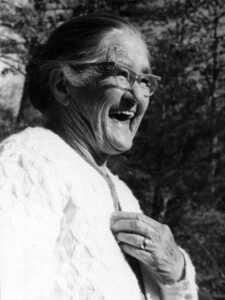Addie Norton
One of Addie’s greatest joys was singing. In Appalachia, shape-note singing dominated musical and religious groups. Shape-note music uses different shapes, like squares, triangles, and diamonds, to represent notes instead of traditional music notes. The shapes enable those who cannot read or cannot read music to understand the melody and flow of the music. Shape-note music also lacks a key signature, making it more approachable to a wider audience. Rather than emphasizing technique and precision like classical music, shape-note focuses on bringing a community of people together in song and worship. In the mountains, people would come together for singings—a special event where they all sang together for hours at a time. In a rural area dotted with small, independent farms, events such as this were important to building community and relationships. The pure joy Addie shares illustrates just how important singing was as part of the community culture.

I can’t remember when I started singing. I’ve sung all my life. My father was as good a bass singer as I think I’ve ever heard. If God gave me a talent, it was for singing. And I love it, honey. I have never been as near heaven of anything else in my life as I have at a singing. It’s the most glorious, wonderful experience! It was special to me, and it is yet. Singing has always been more sacred to me than anything in the world, honey. I don’t know why. There’s nothing in the world that bothers your mind if you love to sing. You’re just as happy and as free as you can be if you’re singing a good gospel song.
“I can sing any song I want to, unless it’s too complicated. And I can sing that, too, if I look over it long enough. I can’t sing any songs with the round notes. I know the shaped-notes’ sound, time value, and everything like that, and I can’t read the round notes at all. I didn’t try to learn the lines or spaces much because that’s for the piano, the musician. Sometimes I have to look over a new song two or three times before I can get the time right. If you don’t know the valuation of these notes—the three-quarters and the whole notes and the half notes—you get mixed up. They teach all that in the singing schools. I can pick up a new songbook and look through it and run over the notes and learn the songs. I can’t keep my foot still to save my life when I’m a’listening or when I’m singing a song. I keep time with my foot.
You know, I wanted my children to sing so badly and I’ve not got but one that’s took after Mama—my baby, Neville. Oh, how he loves to sing! He doesn’t know a thing about shaped notes, but he loves to sing. He used to pick a guitar all the time. He doesn’t have much time to do that now and he’s not got anybody to play with him. He used to have a little band of music—guitar and violin and all things like that. When he was about three or so, I took him to church and he always sat in my lap or down by me. I sang alto all the time and you know, honey, he’d sit there and listen to me singing it over one time and he’d take that tune with me next time just as good as I did and sing it just exactly right. I don’t guess he was over three or four years old ‘til he could sing alto just as good as I could.
I know a lot of people don’t love music like I do but it’s just so wonderful, just an inspiration. I never heard but one or two people, though, say that they didn’t love gospel music. How anybody could hate that beautiful spirit that’s in the song, I can’t understand. You know, I don’t listen much to the tune of the song. It’s the words that gets me.”
